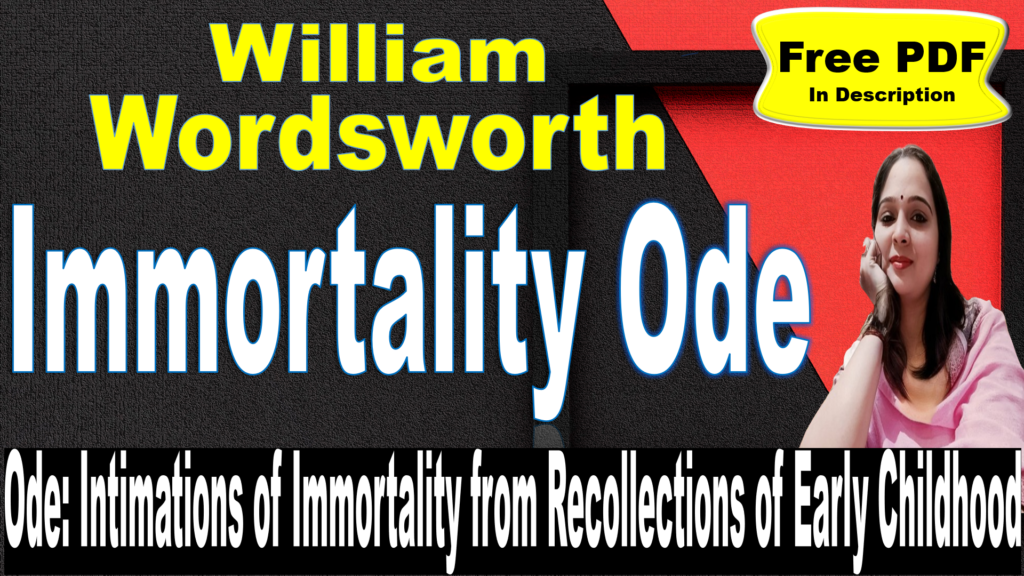
Essay Type Questions
Write the critical appreciation of the poem.
Introduction
William Wordsworth’s “Ode: Intimations of Immortality from Early Childhood” is a famous poem that explores the relationship between childhood, memory, and spirituality. Wordsworth reflects on how our understanding of the divine changes as we grow older and how we can still find comfort in our memories.
Central Idea
The poem’s central idea is that children have a natural sense of the divine and spiritual, but as they grow up, they lose this awareness. Wordsworth discusses how this spiritual insight fades with age but suggests that remembering it can still provide comfort and understanding.
Structure & Rhyme Scheme
The poem is structured into eleven stanzas. Here’s how the poem is organized:
First Four Stanzas: These stanzas talk about the loss of youth and innocence, and how death affects our sense of wonder.
Second Four Stanzas: These stanzas describe how growing older makes us lose touch with our earlier sense of the divine.
Final Three Stanzas: These stanzas offer hope that remembering the divine can help us empathize with each other and find joy.
The poem uses a flexible rhyme scheme, meaning the pattern of rhymes can vary. The lines have a rhythmic pattern called iambic meter, which means they typically follow an unstressed-stressed syllable pattern. The rhymes can alternate, come in pairs, or be scattered within lines.
Theme
The main theme of the poem is the contrast between the spiritual awareness of childhood and the loss of this insight as we age. Wordsworth suggests that even though we lose this divine vision with time, memories of it can still bring us solace and understanding.
Style
Wordsworth’s style is reflective and philosophical. He uses clear language to express deep ideas about human experience and spirituality. His writing is emotional and thoughtful, aiming to connect with the reader’s own experiences and feelings.
Poetic Devices
Imagery: Wordsworth uses vivid images, like “celestial light,” to evoke the divine experience of childhood.
Personification: Nature is given human qualities, such as emotions and actions, to highlight its importance in human life.
Symbolism: Childhood represents a time of divine insight, while adulthood represents the loss of this insight.
Metaphor: Wordsworth compares the fading sense of the divine to “trailing clouds of glory.”
Critical Commentary
Critics have praised the poem for its deep insights and beautiful language. Samuel Taylor Coleridge admired Wordsworth’s ability to blend personal feelings with universal themes. Modern critics appreciate how the poem addresses complex spiritual ideas in a relatable way, highlighting its significance in Romantic literature.
Message
The poem’s message is that while the direct experience of the divine may fade with age, the memories of this experience can still provide comfort and insight. Wordsworth encourages us to cherish and reflect on our childhood experiences, as they help us understand and connect with others.
Conclusion
“Ode: Intimations of Immortality” is a meaningful exploration of how our sense of the divine changes from childhood to adulthood. Wordsworth’s flexible structure and rich use of poetic devices help convey these complex ideas in an accessible and emotional way. The poem remains an important work for its insights into human experience and spirituality.
Long note on themes used in the poem “Ode: Intimations of Immortality”
William Wordsworth’s poem “Ode: Intimations of Immortality from Early Childhood” explores several important themes related to human experience, childhood, and nature. Here’s a simple breakdown of the key themes:
1. The Transience of Human Experience
The poem highlights how the joyful experiences of childhood are fleeting. Wordsworth reflects on how the wonder and beauty seen in youth fade as we grow older. He contrasts the vivid feelings of childhood with the more ordinary view of life that comes with age, showing that these pure moments of joy cannot be fully recaptured.
2. Immortality and Spirituality
Wordsworth discusses the idea that children come into the world with a sense of divine light and spiritual awareness. He suggests that this connection to something greater begins to fade as they age. While direct experiences of spiritual joy may diminish, the memories of these experiences continue to inspire and comfort us throughout life.
3. Nature as a Symbol of Divine Presence
Nature is a major theme in the poem, representing beauty and a connection to the divine. Wordsworth uses images of meadows, hills, and streams to express the spiritual richness of childhood. Nature serves as a reminder of the glory and wonder that once felt so close, even if our perception changes over time.
4. The Role of Memory and Reflection
Memory plays a crucial role in the poem, as Wordsworth emphasizes that while we may lose the direct experience of childhood joy, the memories remain. These memories allow us to reconnect with the feelings and spiritual insights of our early years, showing how important reflection is for understanding our past.
5. The Philosophical Perspective on Aging
The poem presents a thoughtful view on aging. Wordsworth acknowledges the inevitable changes that come with growing older but also recognizes the wisdom gained through life experiences. He suggests that aging brings both loss and new understanding, with memories helping us find continuity in our journey.
Conclusion
In “Ode: Intimations of Immortality from Early Childhood,” Wordsworth explores themes of loss, memory, and the connection to nature. He reflects on how childhood joy fades but leaves lasting impressions. The poem encourages readers to appreciate the beauty of nature and the importance of memories in maintaining a sense of wonder throughout life.





